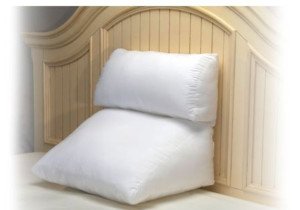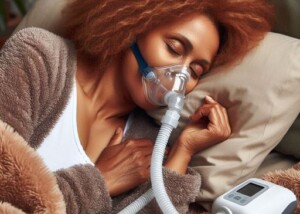
Which is more tolerable for preventing sleep apnea: sleeping upright or sleeping lying down with a CPAP machine on?
This is a million-dollar question to people diagnosed with sleep apnea who can’t stand using a CPAP machine – a special mask that prevents obstructive sleep apnea from occurring.
“People with untreated obstructive sleep apnea tend to find ways to mitigate the problem, often unconsciously — they just find that they sleep better if they do certain things,” begins Joseph Krainin, MD, board certified in sleep medicine and neurology and founder of the online sleep apnea clinic Singular Sleep.
“Raising the head of the bed can definitely help by removing the impact of gravity on promoting upper airway obstruction at the level of the tongue base and soft palate,” continues Dr. Krainin.
“I often encounter patients early in their journey with OSA who sleep with two pillows.
“This may progress, as the disorder gets worse, to only being able to sleep upright in a chair.”
Ever sleep in a chair? It’s not very comfortable unless the chair is reclined somewhat—which then wouldn’t make it really upright.
Of course, there are special implements that you can fashion to your bed to allow you to sleep at nearly a 90 degree angle of trunk flexion relative to your legs.

Theoretically you can prevent sleep apnea by sleeping upright – if you can find a setup that’s tolerable throughout the entire night — such as a wedge pillow.
Your head and neck may be quite comfortable in the upright position using the wedge implement, and even your legs could be quite comfy with a pillow or two beneath your knees.
But your poor butt would probably start getting very uncomfortable shortly into your sleep.
To circumvent that problem you could always use a bed with a mechanism that cranks the mattress upright — and simultaneously cranks up the opposite end to elevate your legs, reducing pressure on your bottom.
These types of beds are pricey, but even if you could easily afford one, you’d still end up being locked in one position — since sleeping on your side while upright would be unbearably uncomfortable.
Thus, sleeping upright is not a practical solution for sleep apnea.
However, if you end up in a situation where you’re separated from your CPAP machine and must go to bed without it…you may want to figure out a way to keep your body propped up overnight.
 In 2013 Dr. Krainin was elected a Fellow of the American Academy of Sleep Medicine, an honor reserved for sleep doctors who’ve made significant contributions to the field in education, research and service.
In 2013 Dr. Krainin was elected a Fellow of the American Academy of Sleep Medicine, an honor reserved for sleep doctors who’ve made significant contributions to the field in education, research and service.
 Lorra Garrick has been covering medical, fitness and cybersecurity topics for many years, having written thousands of articles for print magazines and websites, including as a ghostwriter. She’s also a former ACE-certified personal trainer.
Lorra Garrick has been covering medical, fitness and cybersecurity topics for many years, having written thousands of articles for print magazines and websites, including as a ghostwriter. She’s also a former ACE-certified personal trainer.
.


























